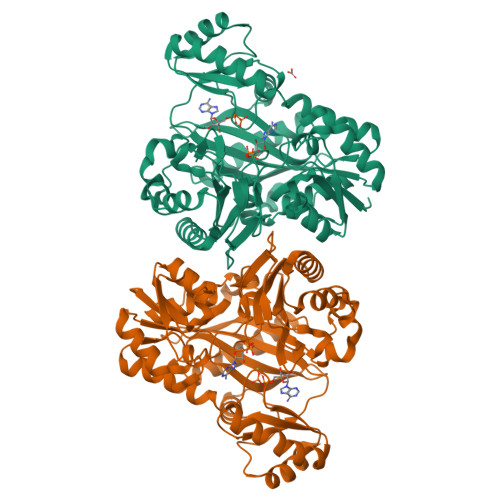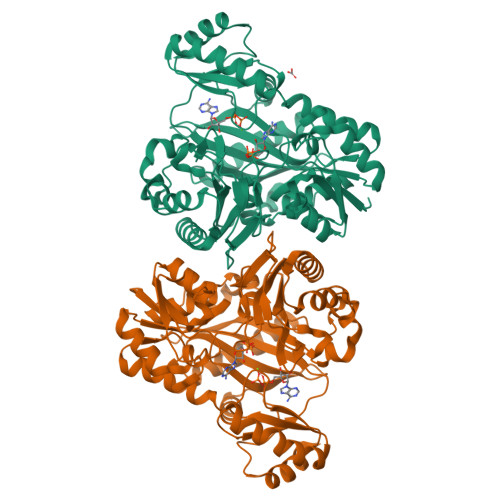Structure, Function, and Thermal Adaptation of the Biotin Carboxylase Domain Dimer from Hydrogenobacter thermophilus 2-Oxoglutarate Carboxylase.
Buhrman, G., Enriquez, P., Dillard, L., Baer, H., Truong, V., Grunden, A.M., Rose, R.B.(2021) Biochemistry 60: 324-345
- PubMed: 33464881
- DOI: https://doi.org/10.1021/acs.biochem.0c00815
- Primary Citation of Related Structures:
7KBL, 7KC7, 7KCT - PubMed Abstract:
2-Oxoglutarate carboxylase (OGC), a unique member of the biotin-dependent carboxylase family from the order Aquificales, captures dissolved CO 2 via the reductive tricarboxylic acid (rTCA) cycle. Structure and function studies of OGC may facilitate adaptation of the rTCA cycle to increase the level of carbon fixation for biofuel production. Here we compare the biotin carboxylase (BC) domain of Hydrogenobacter thermophilus OGC with the well-studied mesophilic homologues to identify features that may contribute to thermal stability and activity. We report three OGC BC X-ray structures, each bound to bicarbonate, ADP, or ADP-Mg 2+ , and propose that substrate binding at high temperatures is facilitated by interactions that stabilize the flexible subdomain B in a partially closed conformation. Kinetic measurements with varying ATP and biotin concentrations distinguish two temperature-dependent steps, consistent with biotin's rate-limiting role in organizing the active site. Transition state thermodynamic values derived from the Eyring equation indicate a larger positive Δ H ⧧ and a less negative Δ S ⧧ compared to those of a previously reported mesophilic homologue. These thermodynamic values are explained by partially rate limiting product release. Phylogenetic analysis of BC domains suggests that OGC diverged prior to Aquificales evolution. The phylogenetic tree identifies mis-annotations of the Aquificales BC sequences, including the Aquifex aeolicus pyruvate carboxylase structure. Notably, our structural data reveal that the OGC BC dimer comprises a "wet" dimerization interface that is dominated by hydrophilic interactions and structural water molecules common to all BC domains and likely facilitates the conformational changes associated with the catalytic cycle. Mutations in the dimerization domain demonstrate that dimerization contributes to thermal stability.
Organizational Affiliation:
Department of Molecular & Structural Biochemistry, North Carolina State University, Raleigh, North Carolina 27695-7622, United States.





















